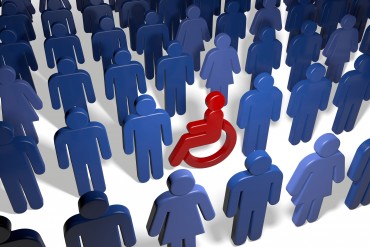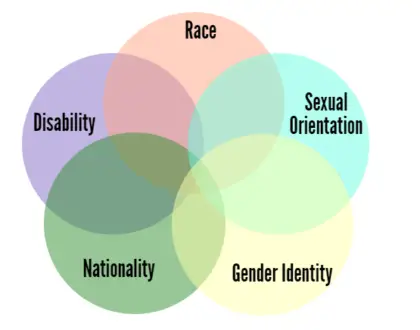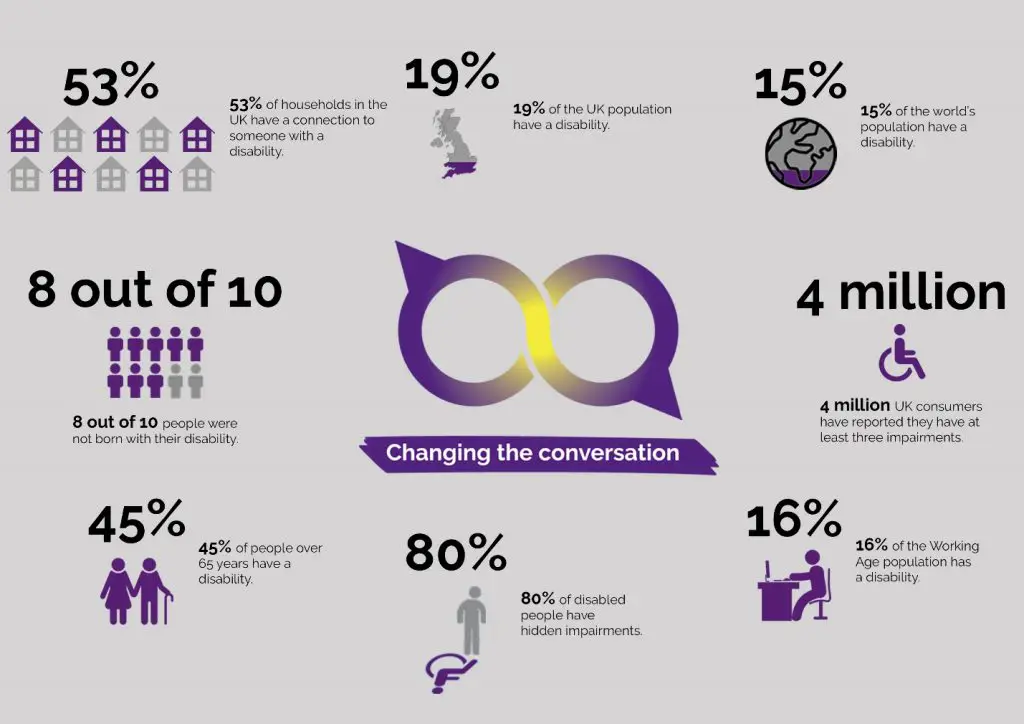The Centers for Disease Control and Prevention (2020) notes that disabilities affect approximately 61 million Americans (the equivalent of 1 in 4 persons) and are defined as “any condition of the body or mind (impairment) that makes it more difficult for the person with the condition to do certain activities (activity limitation) and interact with the world around them (participation restrictions),”(Centers for Disease Control and Prevention, “Disability and Health Overview,” 2020). There are a wide range of cognitive and physical disabilities that a person can have, some of which may or may not be visible to the eye.
Depending on severity, one can be stricken with a disability for any number of reasons, including but not limited to: chromosomal and genetic abnormalities, embryonic developmental issues (an abnormality can be caused in the fetus through the actions of the mother in how they take care of their body and exposure to toxins in the environment, such as smoking, drinking alcoholic substances, or using drugs), or as consequences of an injury or disease.
Regardless of their origin, disabilities can last for any length of time. They may be categorized as belonging to one of three categories: progressive (the condition worsens), static (it remains stable and unchanging), or intermittent (symptoms come and go), (Centers for Disease Control and Prevention, “Disability and Health Overview,” 2020). Considering that this is such a prevalent issue affecting so many lives, this qualifies it as a significant, yet underrepresented, social problem.
Despite the fact that these people may be suffering disabilities as a result of poor health, this does not eliminate their chances for suffering health problems caused by their disability. Studies have shown that handicapped individuals such as these are far more likely to suffer from heart disease, diabetes, stroke, or cancer and they are more likely to be smokers, (Centers for Disease Control and Prevention, “Disability Inclusion,” 2020). Sadly enough, this population also suffers from neglect to a disproportionate and unacceptable level. This comes as a result of both unintentional and intentional discriminatory practices, inadequate access, and a general lack of public education.
All of these things serve to victimize and alienate people that already have to deal with all of the struggles that having a disability entail. However, the physical health of this population is not the only thing that these people suffer; their mental health suffers as well. According to the statistical evidence, individuals with disabilities report experiencing frequent mental distress at a rate of nearly five times more than adults that do not have them, (Centers for Disease Control and Prevention, “The Mental Health of People with Disabilities,” 2020).
In other societal areas, there are precautions to provide necessary protections for at-risk populations (a relatively simple example would be the content advisories and trigger warnings that we see at the beginning of TV shows, movies, or even preceding some of the educational content in schools, universities, colleges, and other institutions). Oddly enough, people with disabilities have seemed to be exempt from receiving many such warnings and cautions.
While further delving into policy issues and legal matters is beyond the scope of this essay, I wish to call attention to a very subtle form of discrimination that has taken on a new role in modern culture. It is fairly common knowledge that outright discrimination is illegal and prohibited by law, but that does not mean that all forms of it have ceased to exist. Quite the opposite is true, in fact.

Discriminating against someone because of their disabilities is what is known as ableism. Ableism has become deeply rooted in our society and in public behavior. Just like other ‘-isms,’ such as sexism and racism, it is a form of judgement and prejudice that has many harmful consequences when and where it exists.
In order to put an end to ableist standards, laws, and policies, we must first change the way that the public sees disabled people. There is an overwhelming lack of awareness present, further compounding the issue regarding disability inclusion. The general lack of awareness of disability is understandable, considering the way that such individuals are portrayed in the media, particularly so in the film industry. It is with the media that the true problem stems from – handicapped individuals are commonly depicted in unrealistic and demeaning ways.
Ableist behavior is not specific to film, but that is the focus of this essay. Film and television have been called “the greatest form of socialization,” as it is estimated that 99.5 percent of households own a television set and the average child spends about 50 percent more of their time watching TV than they spend going to school (Elliott & Byrd, 1982). Unfortunately, misrepresentations of disabled people abound in these mediums and this essay cannot hope to address them in all their forms.
The stereotypes depicted in the video above are far from the only ones. If all representations were as obvious as those, the views that they create might be easier to correct. But the issue is far more complicated than that.
For example, many of the portrayals of people with disabilities are only ableist enough for the disabled themselves to detect; the ableism is so subtle as to go unnoticed by the general public. Sometimes, television and film programs can be guilty of advancing implicitly ableist views unintentionally. When researching this topic, I was surprised to find that many well-loved examples of modern cinema are evidence of such behavior.
I, myself, have noticed that characters tend to be stricken with a disability merely to advance the plot or run time of the program. Often, the issue is resolved in the span of one episode or so; otherwise, they learn to live with and adapt to it before the condition becomes stressful for the audience. This is simply unrealistic storytelling. It is no secret that being diagnosed with any kind of medical handicap is a life-changing event; indeed, it causes much stress to the person afflicted and to the people around them. Problems such as these do not have an easy solution and cannot be hidden away the moment they rear their head or become unpleasant to deal with. Programs that portray things in this way are being unintentionally ableist.
Moreover, people with disabilities can also be used as a way to garner pity. As has been referenced in numerous articles, telethons are a great example of this; this strategy has also been used in fundraisers. Although inspiring help and evoking feelings of pity are very useful if the goal is to raise donations, it simultaneously projects and encourages the public to view the handicapped as incompetent and helpless populations, which is a perception that undermines the values of a seemingly equal society.
A more drastic example is the view of the deformed and disabled as a correlation to “an evil and malevolent nature and monstrous behavior,” a view strongly perpetuated in the film industry in past years. Villains have often appeared as deformed and crazy individuals, while the heroes tend to be the perfect picture of health and beauty. This is what has led disability to be used as a metaphor, (Canadian Journal of Communication, 1993).
Portrayals such as this are perhaps the most hurtful and damaging. They unintentionally encourage able-bodied individuals to assume negative behavior from the disabled. This view encourages both individual and institutional discrimination. As has been shown to be true of racism, there is harm in prejudice. Prejudice – believing that someone is of less and different value than oneself – is different from discrimination – allowing such people unequal access or opportunity. While discrimination against disabled people tends to be illegal, prejudice is not and is very much accepted in our culture.
A special note is necessary to include here. Having a disability qualifies one as a minority. This status is problematic in itself, but is even more complicated if the person is already part of a minority group. Logic dictates that the more minority groups an individual belongs to, the more discrimination they must face. A person can be discriminated against for a variety of reasons: social status, class, sex, gender, sexual orientation, age, ethnicity, religion, and nationality, to name a few. Add disabilities to the list and the result is a smorgasbord of troubles that is nearly impossible to overcome. This brings a multicultural aspect into the picture.

Any social problem that bears repeating relates to at least one of three theoretical paradigms: functionalism, conflict theory, and symbolic interactionism. As defined by our textbook,
“Functionalism emphasizes the importance of social institutions for social stability and implies that far-reaching social change will be socially harmful.
Conflict theory emphasizes social inequality and suggests that far-reaching social change is needed to achieve a just society.
Symbolic interactionism emphasizes the social meanings and understandings that individuals derive from their social interaction,”. (Saylor Academy, 2012).
It is my opinion that conflict theory best exemplifies the social problem of disability inclusion. This lack of social equality for the disabled is a relevant example of what such infarctions in public perception have caused. The facts do not lie –

These figures presented are the objective effects; the data to back up the fact that is a legitimate and significant issue. Unfortunately, the subjective effects are far less easy to interpret due to misrepresentation and underrepresentation – it does not get the attention that it deserves. In my experience, the attention that it does get tends to come from the very people that suffer because of this blatant lack of equality. While it is good that some are speaking out, this is not enough; the way to truly bring about social change is for more people to acknowledge that this inequality exists.
The reason that I believe this is a social problem is because it affects a wide array of people, many of which believe strongly that it is a relevant issue. And finally, it can be remedied by collective action. The first step towards solving inequality is acknowledging that it exists. We can help bring awareness to the masses by representing handicapped individuals more often and more fairly. Merely asking film and media representations to change may seem overly small, but through doing just that, we can successfully alter public attitude. We can hope to rewire our brains to stop implicitly associating disabilities with weakness. When we have achieved this, then we can truly expect more radical social change to make this society truly welcoming to people with disabilities.
References:
- Centers for Disease Control and Prevention. (2020, September 16). Disability Impacts All of Us Infographic. Centers for Disease Control and Prevention. https://www.cdc.gov/ncbddd/disabilityandhealth/infographic-disability-impacts-all.html#text-version.
- . (2020, September 16). Disability and Health Overview. Centers for Disease Control and Prevention. https://www.cdc.gov/ncbddd/disabilityandhealth/disability.html.
- Centers for Disease Control and Prevention. (2020, September 16). Disability Inclusion. Centers for Disease Control and Prevention. https://www.cdc.gov/ncbddd/disabilityandhealth/disability-inclusion.html.
- Centers for Disease Control and Prevention. (2020, November 30). The Mental Health of People with Disabilities. Centers for Disease Control and Prevention. https://www.cdc.gov/ncbddd/disabilityandhealth/features/mental-health-for-all.html#:~:text=A%20recent%20study%20found%20that%20adults%20with%20disabilities,mentally%20unhealthy%20days%20in%20the%20past%2030%20days.
- Chandler, L. (2020, July 2). What is Intersectionality, and What does it Have to Do with Me?. YW Boston. https://www.ywboston.org/2017/03/what-is-intersectionality-and-what-does-it-have-to-do-with-me/.
- Dahl, M. (1993). The Role of the Media in Promoting Images of Disability-Disability as Metaphor: The Evil Crip. Canadian Journal of Communication, 18(1). https://doi.org/10.22230/cjc.1993v18n1a718.
- Elliott, T. & Byrd, E. (1982). Media and Disability. Rehabilitation Literature. 43. 348-55.
- Prazis. (n.d.). Concept Of Inequality And Discrimination Of People With Disabilities Stock Photo – Image of effort, challenge: 110751164. Dreamstime. https://www.dreamstime.com/concept-inequality-discrimination-people-disabilities-silhouette-disabled-worker-wheelchair-stopped-image110751164.
- Saylor Academy. (2012). 1.2 Sociological Perspectives on Social Problems: Key Takeaways. In Social Problems: Continuity and Change.
- TSP Legal. (2016, October 7). Disability Discrimination – Reasonable Adjustments. https://www.tsplegal.com/general/disability-discrimination-reasonable-adjustments/.
- WeArePurple (n.d.). An Overview of Disability – Infographic. https://wearepurple.org.uk/an-overview-of-disability-infographic/.

